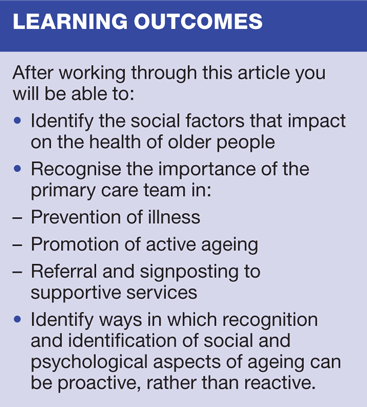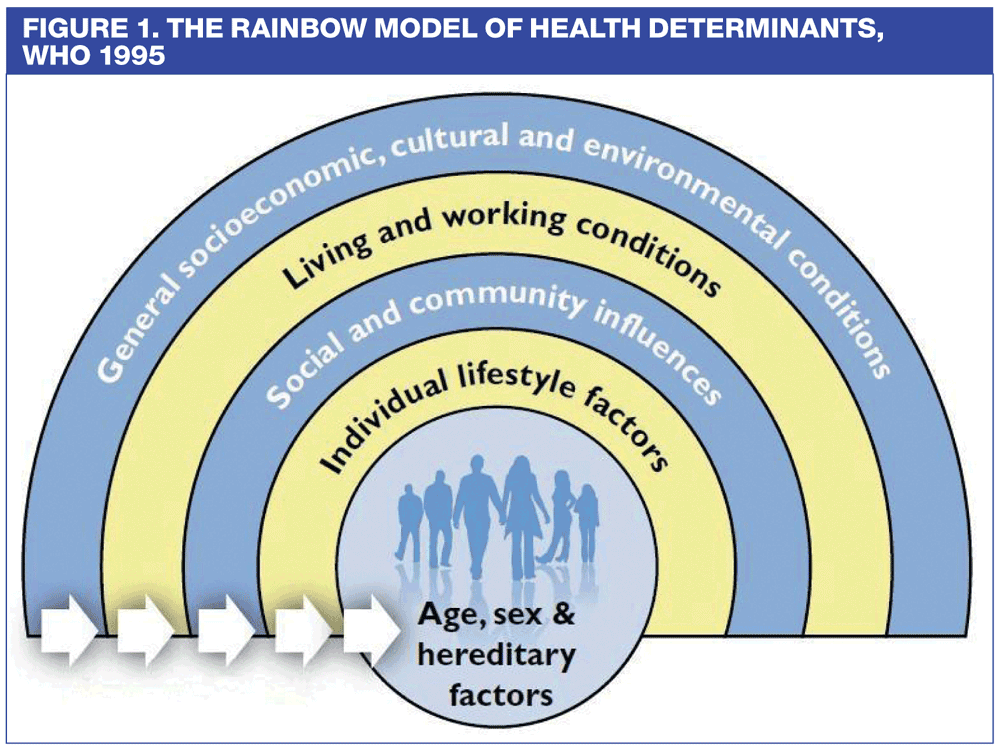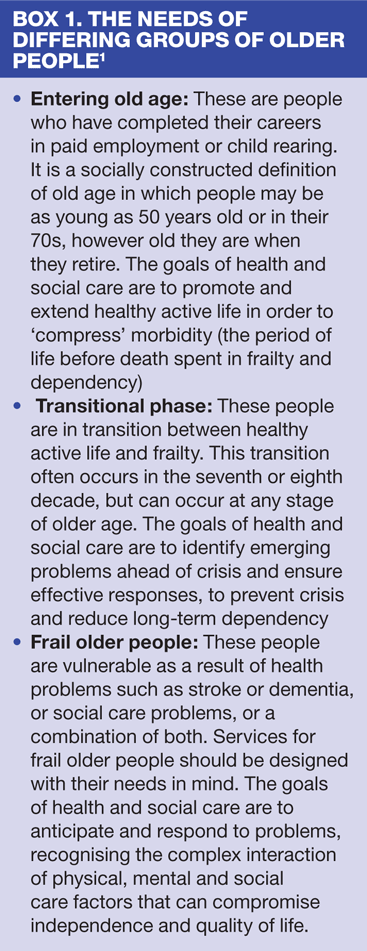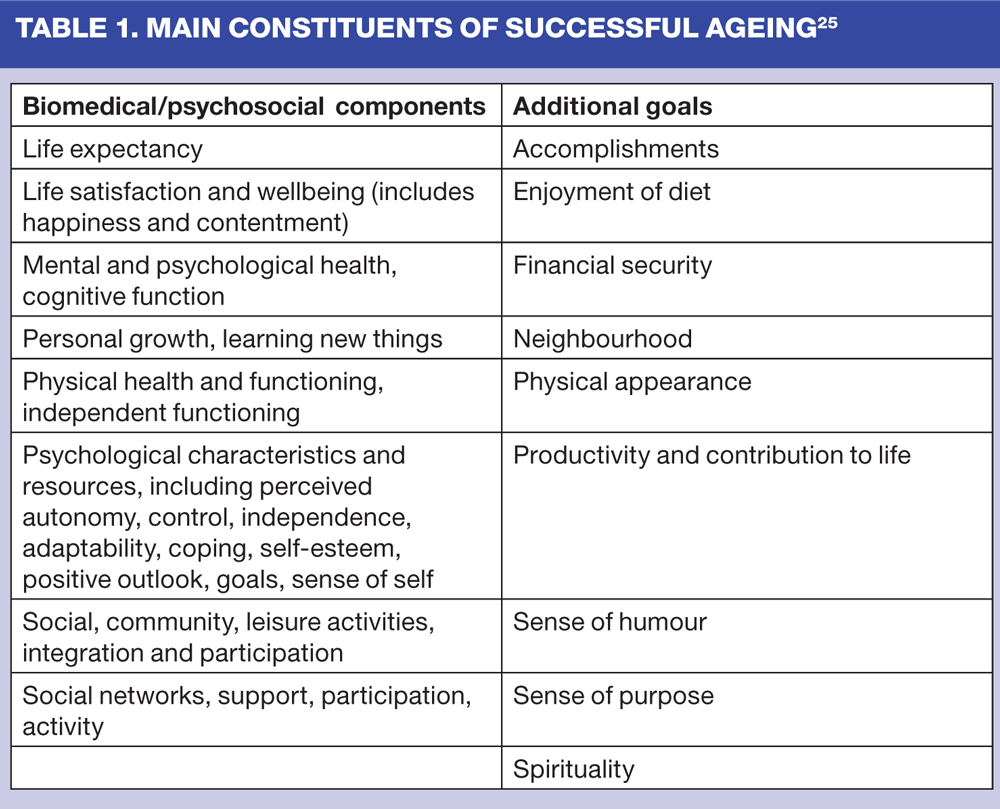Psychosocial aspects of ageing
Ruth Westerby
Ruth Westerby
MSc, BSc, PG Dip Ed (FAHE) RGN
Senior Lecturer in Health and Social Care University of Wolverhampton
In the second part of our series on ageing, we look at how an appreciation of the social and psychological aspects of ageing can help healthcare professionals improve the overall health of older people.
The first article in this two-part series on ageing examined the physiological aspects of ageing, an understanding of which is helpful in establishing what pathology may be associated with the physiological ageing process and what, therefore, might be pertinent when assessing the health of an older person. This second article examines the social and psychological aspects of ageing, which can also have a major impact on wellbeing.
The NSF for Older People1 suggested that, due to demographic and social changes, the view of older people, and services for them needed to change. This was echoed a decade later in the Public Health White Paper, which talked about a need for preventive health services, active ageing initiatives and policies to tackle inequalities.2 The focus of the White Paper was on how public health, working with local authority, could impact on the health of older people. The context of this article is therefore the closer alignment of health with social care, and greater acknowledgement of the impact of social factors on health.
INEQUALITIES
There are many factors that impact on people's health. The inter-relationships of these factors were encapsulated in the 'rainbow model', developed in the early 1990s,3 (Figure 1) which encompasses service provision and considerations about improving access to services. Disadvantage in any area of the 'rainbow' can have a detrimental effect on health.
The effects of disadvantage accumulate over the course of a lifetime.4,5 Factors such as poor housing, poverty, bereavement, loneliness and low levels of perceived social support within the older population show a strong association with objective measures of poor health.
A recent study demonstrated a parallel social gradient between the reporting of longstanding ill-health and awareness of health issues; those who are in poorest health are least likely to present.6 The study has also suggested that those elderly who live in poor housing and/or poverty have poorer mental health, and a higher incidence of anxiety and depression.
In 'Agenda for Later Life 2012',7 Age UK points out that some groups of older people experience much poorer health than others. They highlight some key facts:
- Women live longer than men, but can expect to live, on average, one more year in poor health.
- Over half of people over 75 years report a limiting, longstanding illness.
- There is a gap of 8 years in life expectancy between the richer and poorer local authority areas. People in the poorer areas are not only dying younger, but are spending more of their lives unwell.
- Older people from black Caribbean, Indian, Pakistani and Bangladeshi backgrounds have a greater prevalence of longstanding illness than the general population.
- Becoming a carer has implications for health in later life.
- There are 1.5 million carers over the age of 60 years, many of whom have long-term health problems of their own.
Primary care consultations per patient-year increase almost three-fold between the ages of 60 and 90 years.8 There is some evidence of income-related inequality of access to specialist services, but less evidence of inequality of access to GPs.9 Since the GP remains the 'first port of call' there is potential for primary care to improve the health of older people and their carers by improving their access to specialist services.
It is important to avoid stereotypical views of older people, but it is sensible to identify some of the more common, key characteristics of psychosocial health in older people before moving on to look at ways in which primary care teams can be more proactive in their approach. There are ways in which identifying these characteristics can help in the planning of effective interventions.
DEPRESSION ANDLONG-TERM CONDITIONS
The prevalence of depression, and sub-threshold depressive symptoms persisting for more than two years (dysthymia), increases with age.10,11 The prevalence of depression is around 23% in people with two or more chronic physical disorders, in comparison with 3.2% in 'healthy' people. Later life can give people more reasons to feel 'down', such as stopping work, having less money, having health problems, or experiencing the death of a partner or friends.12
The overall prevalence of depression among older people is relatively high at approximately 23%. Around 18% of older people feel depressed to the extent that other people notice, and just over 3% become ill with depression. A challenge, therefore, is to identify and support people with appropriate services in order to prevent depression from worsening. Treatment for depression in older people is as effective as it is for younger people.
Two-thirds of the population with a limiting, long-standing illness or disability are over 55 years old.13 Within this group, however, there is little homogeneity, and significant inequality. Older people who are likely to experience poorer health, multiple morbidity and diminished life span are those who:
- struggle with poverty
- belong to a black and minority ethnic group
- are in prison
- have a learning disability, or
- are disabled.
Therefore, the experience of poorer health in older age is, at least in part, socially related.14
In addition, there are particularly common forms of multiple morbidity, with mental health problems such as anxiety or depression, or neurological problems such as dementia, occurring alongside diabetes, arthritis or cardiovascular disease.15—17
The NICE guidance on depression in adults with a chronic health problem contains a useful algorithm,18 the first step of which is to ask a patient with chronic disease the screening questions incorporated in the QOF for long-term conditions:
- During the last month have you often been bothered by feeling down, depressed or hopeless?
- During the last month have you often been bothered by having little interest or pleasure in doing things?
These questions are more specific and likely to elicit a meaningful response than a well intentioned 'How are you feeling?' Positive responses to either of these questions should prompt a more comprehensive assessment, which includes a review of the treatment and management of the chronic disease as well as social changes or conditions that may be acting as some form of trigger for depression.
AGEISM
The Equality Act 2010 prohibited age discrimination against people aged 18 years and over when providing a service or public function,19 which clearly includes the NHS and Social Care. However, the NHS Ombudsman Report20 of ten investigations into the NHS care of older people in 2011 is a stark reminder of how vulnerable older people can be, and how services need to ensure that age becomes a factor to include in assessment, rather than a barrier to the provision of care.
This is not to say that we should avoid discussing death and dying: failure to do so means that too many older people approach the end of their lives without having been involved in thinking or planning for how or where they would like to be cared for. Death can also be a trigger for the development of mental and physical health issues for the bereaved family and carers.
Ageist attitudes may also prevent referral to exercise or expert patient programmes, both of which are of known to benefit both physical and mental health.21
THINKING ABOUT AGE
How can health professionals respond to health inequalities, the complexity of health issues, the impact of changes in social environment and financial status, and the challenges to provide person-centred and non-discriminatory care? One way, perhaps, is to consider the way that the National Service Framework1 grouped older people:
- Entering old age
- Transitional phase
- Frail older people.
Box 1 summarises how the Framework described the differing needs and the goals of the Framework for these three groups. The activities that primary care teams could undertake at these different stages might include:
- Entering old age: signposting to opportunities for physical activity, development of a 'life check' facility on retirement, integration with information and advice services.
- Transitional phase: review of chronic illnesses, development of a plan for care, identification of social support networks, referral for Social Assessment, financial advice.
- Frail older people: consideration of case management, instigation of regular medication review, integration of health and social care provision.
Recent work has illustrated that it is possible, through use of practice data, to start to stratify people in terms of their 'risk'.22—24 Depending on whether people fall into low, medium or high risk categories depends on whether they require services ranging from telephone support, referral through to case management and collaborative care planning. Two simple examples of this approach include:
- The invitation for a life check on retirement
- A telephone call and invitation for a health assessment
- for those known to have suffered bereavement
- for people who have not accessed healthcare for a specified period of time
- for those providing care.
This type of predictive and proactive work might appear, on the one hand, to be concerned with saving of downstream service costs, but on the other, it is also about knowing your patients.
Thinking about ageing on an individual patient basis can be even more challenging. We have all experienced the contrast between an older person who has a number of physical ailments but appears to be relatively unconcerned and lives 'life to the full' despite restrictions on mobility and discomfort, and the older person who appears to find the restrictions of living with a chronic condition almost unbearable.
It can be argued that healthcare professionals are pre-occupied with the medical model of ageing.25 The result is a focus on the burden of old age and the decline and failure of the body. In contrast, the key components of successful ageing from a psychosocial perspective are the offsetting of functional loss with life satisfaction, social participation and social functioning, and the development of psychological resources, including personal growth. Autonomy and independence, effective coping and adaption are key. Components of the biomedical and psychosocial model for successful ageing, and the additional criteria identified by lay participants in the research are summed up in Table 1.
The conclusions drawn from this work were that health professionals need to examine their own assumptions and respect the values and attitudes of each elderly person with whom they have contact.25 On a more pragmatic level it is important to recognise that those most in need may be the least likely to ask for it. This may be due, at least in part, to low expectations about what services can offer and a low expectation of their own ability to have a successful old age. This understanding is a step towards health professionals being able to identify ways in which they can meet the challenges that these low expectations present.
In 2008 Age Concern published a collection of individual stories that presented a compelling picture of how effective information and advice can be in resolving problems, ranging from inadequate finances to loneliness.26 A key fact to emerge from this publication was that although 89% of respondents had chronic health conditions which meant that they were in contact with health professionals, only 19% of referrals to Age Concern's specialist advisors were from health professionals.
CONCLUSION
There are a number of ways that health professionals can think, speak and act in relation to older people that can make a difference to their over all health. Thinking about chronological age alongside cognitive, social, emotional and personality strands within individuals makes a difference to the qualitative aspects of their lives.
Supportive services for older people are there, but referral to them is inconsistent. Learning what is available in your geographical area will help you to help your ageing patients live life to the full.
REFERENCES
1. Department of Health. National Service Framework for Older People. DH. 2001 http://www.dh.gov.uk/en/Publicationsandstatistics/Publications/PublicationsPolicyAndGuidance/DH_4003066
2. Department of Health (2010) Healthy Lives, Healthy People: Our strategy for Public Health in England. DH. November 2010 http://www.dh.gov.uk/en/Publicationsandstatistics/Publications/PublicationsPolicyAndGuidance/DH_121941
3. Dalgren G. European Health Policy Conference. Opportunities for the Future Vol 1, Intersectorial Action for Health, Copenhagen: WHO Regional Office for Europe. 1995
4. Graham H. The Health Variations Programme and the Public Health Agenda. Health Variations 2001; Issue 7: 2-3
5. Grundy E, Holt G. Health Inequalities in the older population. Health Variations 2001; Issue 7: 4-5
6. Howden-Chapman PL, Chandola T, Stafford M, Marmot M. The effect of housing on the mental health of lifetime housing history in Whitehall II. Biomed Central; BMC Public Health 2011; 11: 682 http://www.biomedcentral.com/1471-2458/11/682
7. Age UK. Agenda for Later Life; Policy Priorities for active ageing. Age UK. 2012 http://www.ageuk.org.uk/Documents/EN-GB/For-professionals/Policy/AgendaforLaterLifeReport2012.pdf?dtrk=true
8. Health and Social Care Information Centre (2009) Trends in Consultation Rates in General Practice 1995-2009. http://www.ic.nhs.uk/pubs/gpcons95-09
9. Allin S, Masseria C, Mossialos E. Equity in health care use among older people in the UK: an analysis of panel data. Applied Economics 2011; 43(18): 2229-2239
10. National Collaborating Centre for Mental Health. Depression in adults (update): full NICE guideline. National Institute for Health and Clinical Excellence. 2009 www.nice.org.uk
11. National Collaborating Centre for Mental Health (2009b) Depression in adults with a chronic physical health problem; treatment and management. 2009 www.nice.org.uk
12. Royal College of Psychiatrists. Depression in older adults. 2012 http://www.rcpsych.ac.uk/expertadvice/problems/depression/depressioninolderadults.aspx
13. Medical Research Council. Topic Review: The Health of the UK's Elderly people, London, Medical Research Council. 1994
14. Ongle KS, Swanaon GM, Woods N, Azzouz F. Cancer and Co-morbidity: redefining chronic diseases. Cancer 2000; 88(3): 653-63
15. Chapman DP, Perry GS, Strine TW. The Vital Link between chronic disease and depressive disorders. Preventing Chronic Disease 2005; 2(1): A14
16. McVeigh KH, Sederer LI, Silver I, et al. Integrating care for medical and mental illnesses. Preventing Chronic Disease 2006; 3(2): A33
17. Roy-Byrne PP, Stein MB, Russo JE et al. Medical Illness and response to treatment in primary care panic disorder. General Hospital Psychiatry 2005; 27(4): 237-43
18. National Institute for Health and Clinical Excellence (2009) Depression with a chronic health problem. CG91 available at http://www.nice.org.uk/cg91
19. The Equality Act. 2010 http://www.legislation.gov.uk/ukpga/2010/15/contents
20. Parliamentary and Health Service Ombudsman. Care and compassion? Report of the Health Service Ombudsman on ten investigations into NHS care of older people. 2011. available at http://www.ombudsman.org.uk/care-and-compassion/home )
21. Mather AS et al. Effects of exercise on depressive symptoms in older adults with poorly responsive depressive disorder. Brit J Psych 2002; 180: 411-415.
22. Goodwin N, Curry N, Naylor C, Ross S, Duldig W. Managing people with long-term conditions. London. The Kings Fund. 2011
23. Hutt R, Rosen R, McCauley J. Case Managing Long Term Conditions. London. The Kings Fund. 2004
24. Hutt R, Rosen R. A Chronic Case of Mismanagement? Journal of Health Services Research Policy 2005; 10(4): 194-95
25. Bowling A, Dieppe P. What is successful ageing and who should define it? BMJ 2005; 331: 1548-51
26. Age Concern. Transforming Lives; Tackling poverty and promoting independence and dignity through information and advice. Age Concern. 2008
Related articles
View all Articles






